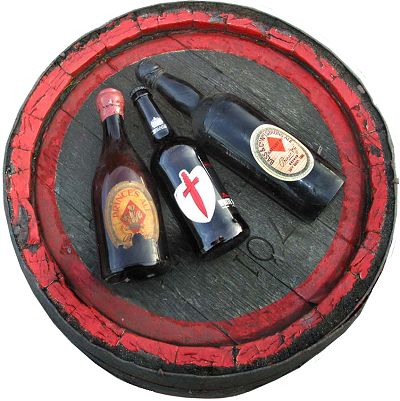| |
Old Beers
by Willard Clarke, 04/07
Those of us that chip away at the coalface labelled "beer" constantly stress that our preferred form of alcohol deserves as much attention and respect as wine. The juice of the barley can be as complex and profound as the juice
of the grape. Beer is more than just a quick refresher � though there is nothing wrong with such a category and many wines fall into it, too.
But just as some wines improve with age so also do some forms of beer. The increase in the appreciation of bottle-conditioned beers is an indicator of the manner in which beer, left to its own devices on a bed of yeast,
will improve and mature with age.
The case for allowing beers to develop naturally under glass has been given a major boost by the discovery of a cache of old beers, some dating from the 19th century, at the former Bass brewery in Burton upon Trent.
I arranged for a tasting with Steve Wellington, head brewer at the White Shield Brewery in Burton, part of Coors, the American company that acquired the site from Bass.
Most of the beers unveiled by Steve had been brewed to celebrate a royal event, such as a coronation or the birth of a prince or princess. Steve told me that the Burton brewers would also send special bottles to the
royal household at Christmas, often for blending with the festive pudding.
The oldest beer on show had been brewed to commemorate the birth of a child not to the monarch but to a member of the "beerage" - a son for the Ratcliff family. The Ratcliffs were Burton brewers who became part of the
Bass, Ratcliff & Gretton company.
The beer dates from 1869 (it is the bottle to the left of the three beers pictured) and it was with a deep sense of history and a tingle of anticipation that I watched Steve break the wax seal on a bottle that is 138 years old and then remove the
driven cork.
This is where the distinction between beer and wine disappears.
|
|

|
The liquid in the glass was flat and had a superb amber/red colour. The aroma and flavour were fruity, with raisins and sultanas to the fore and some coffee and
chocolate notes. Only a faint hint of bitterness in the finish marks this out as beer. The sweetness, fruitiness and smoky notes suggest it is Oloroso sherry.
The beer is 11% and most of the beers in the tasting were in the range of 10.5 to 11%. A 1902 King's Ale explained why excess brewer's yeast is sold to Marmite as the beer exuded the tangy, salty notes that are the hallmark
of the breakfast spread. There were also powerful hints of blood oranges and figs, and a touch of hop.
A 1929 Prince's Ale was not available to taste as only one bottle exists and it has to be kept for posterity. A 1977 Jubilee Strong Ale was much paler than the older beers. It has massive fruit, reminiscent of plums, damsons and
green apples. It was bittersweet in the mouth while the dry finish had some hop resins and a hint of fresh tobacco.
A 1978 Princess Ale took us back to the sherry notes of the first beer tasted. It had some sourness and mustiness that suggested that Brettanomyces, the wild yeast used in lambic brewing in Belgium, had entered the bottle.
There was some compensating dryness in the finish.
A 1982 Prince's Ale (8%) presented apple aromas to such effect that it was reminiscent of Calvados. There was a herbal note, too, with a rich mouthfeel and a lingering, bittersweet finish.
|
|
The most recent commemorative beers brewed at Burton are a Duke's Ale (6.5%) and a Queens Ale (10.5%), both dating from 2002. The Duke's has performed best, with a lively head, tart citrus fruit and a powerful
spiciness, with good hop notes in the finish. The Queen's, in contrast, was flat and dark, with plums and sultanas and yet more evidence of Marmite yeastiness.
|
Professor Chris Boulton, a senior scientist with Coors, said yeast cells survive for only a few months in bottle. The changes in beer over the years are the result of proteins from malt and hops creating natural chemical
reactions that lead to changes in colour and flavour.
For frustrated readers who cannot taste these remarkable ales, my advice would be to lay down bottles of Worthington's White Shield for at least 10 years and monitor the changes that take place.
|
|